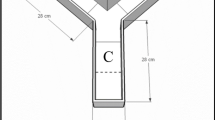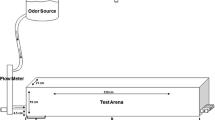Abstract
Grass carp (Ctenopharyngodon idellus) is one of the most essential fishing species in China. The bait for this fish is rapidly developing. However, the study on the attractants in the bait for this fish lacks. This study was designed to systematically investigate the effects of 16 kinds of test substances on the perspective of behaviour and physiology of grass carp by using different kinds of methods, including behavioral tests (maze test and biting-balls test) and electro-olfactogram (EOG). Our experiment’s idea is mainly to imitate: in addition to vision, fish in nature also use smell to find food and finally swallow under the action of olfaction, taste, and other sensory systems. Firstly, the behavioral maze test was used to screen the attractive or suppressive effect of 16 test substances on grass carp, and the electronic olfactory recording method was used to further evaluate the olfactory response of grass carp to the eight stimuli selected from the maze test. Then, the best concentrations of these eight stimuli and their combination were investigated by the biting-balls test to compound a formula with the strongest appetite for grass carp. The results of behavioral maze test showed that dimethyl-β-propiothetin (DMPT), dimethylthetin (DMT), glycine, taurine, l-glutamic, l-alanine, l-proline, and l-arginine have different degrees of usefulness in attracting grass carp. The electro-olfactogram recoding showed that the EOG response of grass carp to the stimuli is a transient biphasic potential change and all of the eight stimuli could induce the EOG response of grass carp. The biting-balls test showed that glycine, l-glutamic, and l-arginine at 10−2 mol/L had significant feeding stimulation and DMT at 10−1 mol/L had significant feeding stimulation than the other groups. Finally, formula 9 composed of DMT, glycine, l-glutamic acid, and l-arginine has the greatest attraction for grass carp. The results of this study verified the attractive effect of some amino acids and other chemicals on grass carp fishing, and would provide support for the production of specific grass carp attractants.







Similar content being viewed by others
Data availability
The datasets generated during and/or analyzed during the current study are available from the corresponding author on reasonable request.
Code availability
Not applicable
References
Caprio J (1980) Similarity of olfactory receptor responses (EOG) of freshwater and marine catfish to amino acids. Can J Zool 58:1778–1784. https://doi.org/10.1139/z80-245
Carlberg H, Cheng K, Lundh T, Brnns E (2015) Using self-selection to evaluate the acceptance of a new diet formulation by farmed fish. Appl Anim Behav Sci 171:226–232. https://doi.org/10.1016/j.applanim.2015.08.016
Chaudhari N, Pereira E, Roper SD (2009) Taste receptors for umami: the case for multiple receptors. Am J Clin Nutr 90:738S-742S. https://doi.org/10.3945/ajcn.2009.27462H
Franklyn A, Wang Y, Yu N, Wang J, Le Q (2017) Transcriptome analysis reveals L-amino acids as olfactory stimulant in the large yellow croaker (Larimichthys crocea). J Aquac Res Dev 8:2. https://doi.org/10.4172/2155-9546.1000475
Getchell TV (1974) Electrogenic sources of slow voltage transients recorded from frog olfactory epithelium. J Neurophysiol 37:1115–1130. https://doi.org/10.1152/jn.1974.37.6.1115
Goh Y, Tamura T (1978) The electrical responses of the olfactory tract to amino acids in carp. J Aquac Res Dev 44:341–344. https://doi.org/10.2331/suisan.44.341
Hara TJ (1975) Olfaction in fish. Prog Neurobiol 5:271–335. https://doi.org/10.1016/0301-0082(75)90014-3
Hara TJ (1994) The diversity of chemical stimulation in fish olfaction and gustation. Rev Fish Biol Fish 4:1–35. https://doi.org/10.1007/BF00043259
Hara TJ (2010) Feeding behaviour in some teleosts is triggered by single amino acids primarily through olfaction. J Fish Biol 68:810–825. https://doi.org/10.1111/j.0022-1112.2006.00967.x
Harada K (1982) The attractive effect of food based on the behavioral responses of juvenile yellowtail Seriola quinqueradiata. Nippon Suisan Gakkai Shi 48:1047–1054. https://doi.org/10.2331/suisan.48.1047
Harada K, Abe Y, Sugiyama T (1988) Activities of carboxylic acids and acidic amino acids as repellents in the oriental weatherfish Misgurnus anguillicaudatus. Nippon Suisan Gakkai Shi 54:2135–2138. https://doi.org/10.2331/suisan.54.2135
Harada K, Miyasaki T (1993) Attraction activities of fruit extracts for the oriental weather-fish Misgurnus anguillicaudatus. Nippon Suisan Gakkai Shi 59:1757–1762. https://doi.org/10.2331/suisan.59.1757
Harada K, Miyasaki T, Satoh K (2010) Attractiveness of fishing baits for aquatic animals. Suisanzoshoku 45:351–356. https://doi.org/10.11233/aquaculturesci1953.45.351
Harada K, Miyasaki T, Tamura Y (1995) Attraction of yellowtail, Seriola quinqueradiata for sugars and related compounds. Suisan Zoshoku 43:51–55. https://doi.org/10.11233/aquaculturesci1953.43.51
Hill JV, Davison W, Forster ME (2002) The effects of fish anaesthetics (MS222, metomidate and AQUI-S) on heart ventricle, the cardiac vagus and branchial vessels from Chinook salmon ( Oncorhynchus tshawytscha ). Fish Physiol Biochem 27:19–28. https://doi.org/10.1023/B:FISH.0000021742.30567.2d
Hu J, Le Q, Zhang M, Kuang S, Gu W, Sun Y, Jean Jacques K, Zhang Y, Li Y, Sun J (2021) Effects of amino acids on olfactory‐related receptors regulating appetite in silver pomfret. Aquac Res. https://doi.org/10.1111/are.15102
Ishida Y, Kobayashi H (1992) Stimulatory effectiveness of amino acids on the olfactory response in an algivorous marine teleost, the rabbitfish Siganus fuscescens Houttuyn. J Fish Biol 41:737–748. https://doi.org/10.1111/j.1095-8649.1992.tb02703.x
Jiesheng K, John C (1991) Electro-olfactogram and multiunit olfactory receptor responses to binary and trinary mixtures of amino acids in the channel catfish, Ictalurus punctatus. J Gen Physiol 98:699–721. https://doi.org/10.1085/jgp.98.4.699
Johnsen P, Zhou H, Adams M (1988) Olfactory sensitivity of the herbivorous grass carp, Ctenopharyngodon idella, to amino acids. J Fish Biol 33:127–134. https://doi.org/10.1111/j.1095-8649.1988.tb05454.x
Kasumyan A (1997) Gustatory reception and feeding behavior in fish. J Ichthyol 37:72–86
Kasumyan A (2004) The olfactory system in fish: structure, function, and role in behavior. J Ichthyol 44:S180
Kasumyan A, Mikhailova E (2017) Palatability of stereoisomers and other amino acid derivatives to fish. J Evol Biochem Physiol 53:317–323. https://doi.org/10.1134/S0022093017040081
Kasumyan A, Morsi AK (1996) Taste sensitivity of common carp Cyprinus carpio to free amino acids and classical taste substances. J Ichthyol 36:391–403
Kasumyan A, Sidorov S (2012) Effects of the long-term anosmia combined with vision deprivation on the taste sensitivity and feeding behavior of the rainbow trout Parasalmo (= Oncorhynchus) mykiss. J Ichthyol 52:109–119. https://doi.org/10.1134/S0032945212010079
Kasumyan AO, DÖving KB (2003) Taste preferences in fishes. Fish Fish (Oxf) 4:289–347. https://doi.org/10.1046/j.1467-2979.2003.00121.x
Kawabata K, Sudo S, Tsubaki K, Tazaki T, Ikeda S (1992) Effects of amino acids on pecking behavior of the rose bitterling Rhodeus ocellatus ocellatus. Nsugaf 58:833–838. https://doi.org/10.2331/suisan.58.833
Kenji N, Aritsune U, Yuzaburo I (1989) A new feeding attractant, dimethyl-. BETA.-propiothetin, for freshwater fish. Nippon Suisan Gakkai Shi 55:689–695. https://doi.org/10.2331/suisan.55.689
Kohbara J, Hidaka I, Morishita T, Miyajima T (2000) Gustatory and olfactory sensitivity to extracts of jack mackerel muscle in young yellowtail Seriola quinqueradiata. Aquaculture 181:127–140. https://doi.org/10.1016/S0044-8486(99)00222-7
Lim L-S, Lai JS-K, Yong AS-K, Shapawi R, Kawamura G (2015) A preliminary study on the taste preferences of marble goby (Oxyeleotris marmoratus) for amino acids. Songklanakarin J Sci Technol 37:397–400
Løkkeborg S, Johannessen T (1992) The importance of chemical stimuli in bait fishing—fishing trials with presoaked bait. Fish Sci 14:21–29. https://doi.org/10.1016/0165-7836(92)90070-A
Løkkeborg S, Siikavuopio SI, Humborstad O-B, Utne-Palm AC, Ferter K (2014) Towards more efficient longline fisheries: fish feeding behaviour, bait characteristics and development of alternative baits. Rev Fish Biol Fish 24:985–1003. https://doi.org/10.1007/s11160-014-9360-z
López A, Ferrero F, Valledor M, Campo J C, Postolache O (2016) A study on electrode placement in EOG systems for medical applications, 2016 IEEE International Symposium on Medical Measurements and Applications (MeMeA), IEEE, pp. 1–5. https://doi.org/10.1109/MeMeA.2016.7533703
Ma XL, Hong WS, Chai MJ, Pan LA, Hung HY, Zhang QY (2003) Comparison of olfactory responses of snakehead fish Channa argus to sex pheromones. Xiamen Da Xue Xue Bao Zi Ran Ke Xue Ban 42:781–786. https://doi.org/10.3321/j.issn:0438-0479.2003.06.022
Miyasaki T, Harada K, Maeda H (1999) Statistical estimation of probable feeding attractive amino acids for abalone in vegetable extracts. Suisan Zoshoku 47:455–456. https://doi.org/10.11233/aquaculturesci1953.47.455
Murphy CA, Stacey NE, Corkum LD (2001) Putative steroidal pheromones in the round goby, Neogobius melanostomus: olfactory and behavioral responses. J Chem Ecol 27:443–470. https://doi.org/10.1023/A:1010376503197
Olsén KH, Sukovich N, Backman J, Lundh T (2018) Chemical foraging stimulation in the omnivorous species crucian carp, Carassius carassius (Linnaeus 1758). Aquac Rep 12:36–42. https://doi.org/10.1016/j.aqrep.2018.09.003
Ozorio ROA, Hubbard PC, Barata EN, Valente LMP, Canário AVM (2010) Olfactory Sensitivity to amino acids in the blackspot seabream (Pagellus Bogaraveo, Brünnich 1768): how effective is the electro-olfactogram in seawater? Eur Aquac Soc:946–947. https://doi.org/10.1007/s00359-011-0646-5
Saglio P, Fauconneau B, Blanc J (1990) Orientation of carp, Cyprinm carpio L., to free amino acids from Tubifex extract in an olfactometer. J Fish Biol 37:887–898. https://doi.org/10.1111/j.1095-8649.1990.tb03592.x
Tine V, Aleš K (2000) Coding principles in fish olfaction as revealed by single unit, EOG and behavioral studies. Pflugers Arch 439:R193–R195. https://doi.org/10.1007/s004240000142
Wu Y, Bao H, Wu W, Fang W (1993) Feeding attraction activties of amino acids for crucian carp(Carassius auratus auratus) and loach(Misgurnus anguillicaudatus). Shuichan Xuebao 17:337–339. CNKI:SUN:SCKX.0.1993-04-010
Yamada H, Nakatani K (2001) Odorant-induced hyperpolarization and suppression of cAMP-activated current in newt olfactory receptor neurons. Chem Senses 26:25–34. https://doi.org/10.1093/chemse/26.1.25
Zhang HM, Xia MS, Cai-Hong HU (2005) Preliminary study on feeding attraction activities of TMAO for Penaeus vanname. J Northwest Sci-Tech Univ Agric For. https://doi.org/10.1360/biodiv.050121
Zhao HY (2007) Studies on feeding stimulants for gibel carp (Carassius auratus gibelio). Doctoral Dissertation,Institute of Hydrobiology, Chinese Academy of Sciences.in Chinese with English abstract (In Chinese with English abstract)
Zou Q, Huang Y, Cao J, Zhao H, Wang G, Li Y, Pan Q (2017) Effects of four feeding stimulants in high plant-based diets on feed intake, growth performance, serum biochemical parameters, digestive enzyme activities and appetite-related genes expression of juvenile GIFT tilapia (Oreochromis sp.). Aquac Nutr 23:1076–1085. https://doi.org/10.1111/anu.12475
Funding
This study was financially supported by the National Key R&D Program of China (2019YFD0900200).
Author information
Authors and Affiliations
Contributions
All authors contributed to the study conception and design, material preparation, data collection, and analysis. The first draft of the manuscript was written by Haojie Yu, while XiaoYu Wang, Fanshuang Kong, and Qingsong Tan commented on previous versions of the manuscript. Qingsong Tan received the funding. All the authors read and approved the final manuscript.
Corresponding author
Ethics declarations
Ethics approval
With the submission of this manuscript, I would like to confirm that the abovementioned manuscript has not been published elsewhere, accepted for publication elsewhere, or under editorial review for publication elsewhere and that my Institute’s Key Laboratory of Freshwater Animal Breeding, Ministry of Agriculture of China/Hubei Provincial Engineering Laboratory for Pond Aquaculture/College of Fisheries, Huazhong Agricultural University, Wuhan 430070, China representative is fully aware of this submission. All procedures were approved by the Institutional Animal Care and use Committee (IACUC) of Huazhong Agricultural University (Wuhan, China) for laboratory animal use. Culturing of fish was performed according to the common Organization for Economic Cooperation and Development (OECD) protocol for fishes.
Consent to participate
Agree
Consent for publication
Agree
Conflict of interest
The authors declare no competing interests.
Additional information
Publisher's note
Springer Nature remains neutral with regard to jurisdictional claims in published maps and institutional affiliations.
Rights and permissions
About this article
Cite this article
Yu, H., Wang, X., Kong, F. et al. The attractive effects of amino acids and some classical substances on grass carp (Ctenopharyngodon idellus). Fish Physiol Biochem 47, 1489–1505 (2021). https://doi.org/10.1007/s10695-021-00990-1
Received:
Accepted:
Published:
Issue Date:
DOI: https://doi.org/10.1007/s10695-021-00990-1




